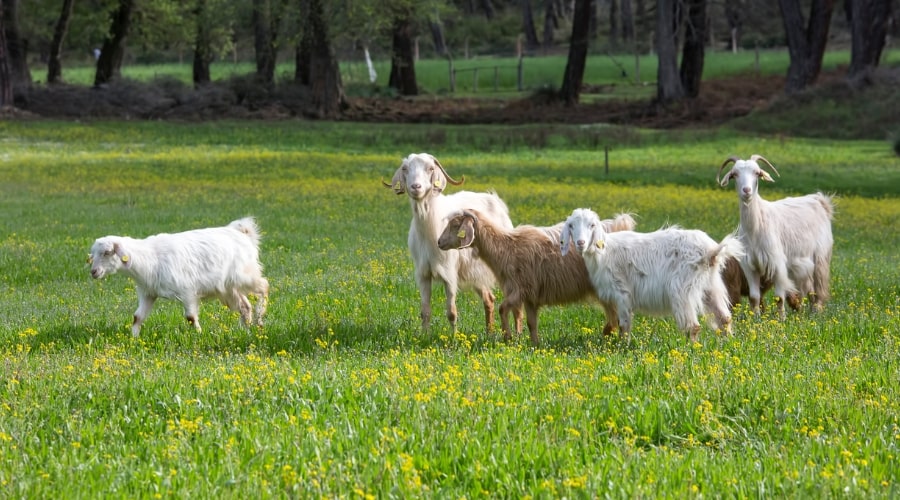Choosing the right dairy goat breed is key to meeting your milk production goals. Each breed offers unique qualities, such as milk yield, fat content, and adaptability. Here’s a guide to help you understand the differences among the most popular dairy goat breeds.
Saanen Goats
Saanen goats are one of the most popular dairy breeds worldwide. They are known for their high milk production, averaging 1 to 3 gallons per day [TO BE VERIFIED]. Their milk has a lower butterfat content, around 2% to 3%, making it ideal for liquid consumption.
These goats are large, typically white or cream-colored, and have a calm temperament. Saanens thrive in cooler climates and require ample shade and water in warmer regions. They are a great choice for farmers aiming for high-volume milk production.
Nubian Goats
Nubian goats are easily recognized by their long, floppy ears. They produce milk with high butterfat content, often exceeding 4%, which is excellent for cheese and yogurt production. Their milk yield ranges from 1 to 2 gallons per day.
Nubians are highly adaptable to various climates, including hot regions. They are friendly and vocal, which makes them a favorite for small-scale farms. However, their smaller milk volume compared to Saanens is offset by the richness of their milk.
Alpine Goats
Alpine goats are known for their consistent milk production and adaptability to different climates. They produce 1 to 2 gallons of milk daily, with a butterfat content of around 3.5%.
This breed comes in a variety of colors and patterns, adding aesthetic value to your farm. Alpines are energetic and thrive in diverse environments, making them suitable for both small and large-scale operations. Their milk’s balanced fat content is ideal for various dairy products.
Toggenburg Goats
Toggenburg goats are among the oldest dairy breeds. They are medium-sized and produce 1 to 2 gallons of milk daily. The butterfat content is slightly lower, around 2% to 3%, but their milk has a mild, pleasant flavor.
These goats are hardy and perform well in cooler climates. Their brown coats with white markings are distinct and easy to identify. Toggenburgs are a reliable choice for farmers prioritizing consistent milk yield over high fat content.
LaMancha Goats
LaMancha goats are unique due to their short, almost non-existent ears. They are excellent milk producers, yielding 1 to 2 gallons per day with a butterfat content of about 4%.
This breed is known for its gentle nature and adaptability to various farming conditions. LaManchas are versatile and can thrive in both small and large herds. Their milk’s richness makes it suitable for diverse dairy products, including butter and cream.
Nigerian Dwarf Goats
Nigerian Dwarf goats are small in size but high in quality milk production. They yield around 1 quart to 1 gallon of milk daily, with a butterfat content often exceeding 6%.
These goats are an excellent choice for hobby farms or small-scale operations. Their rich milk is perfect for specialty products like artisanal cheeses. Nigerian Dwarfs are friendly, easy to handle, and require less space than larger breeds.
Oberhasli Goats
Oberhasli goats are a Swiss breed known for their reddish-brown coats and black markings. They produce 1 to 1.5 gallons of milk daily, with a butterfat content of about 3.5%.
This breed is docile and easy to manage, making it ideal for beginners. Oberhaslis are adaptable and perform well in various climates. Their milk’s balanced fat and protein content is suitable for a wide range of dairy products.
Selecting the Right Breed
When choosing a breed, consider your specific goals. If you need large quantities of milk, Saanens or Alpines are excellent options. For richer milk suitable for cheese and yogurt, Nubians or Nigerian Dwarfs are ideal.
Factor in your local climate and resources. Some breeds, like Toggenburgs and Oberhaslis, perform better in cooler regions, while Nubians and Alpines adapt well to heat. Space availability also matters; smaller breeds like Nigerian Dwarfs require less room and feed.
Checklist for Choosing a Dairy Goat Breed
- Determine your primary goal: high yield or high butterfat.
- Research breeds suited to your climate and resources.
- Start with a small herd to minimize initial costs.
- Source healthy goats from reputable breeders.
- Match breed characteristics to your dairy product plans.
By selecting the right breed, you set the foundation for a successful dairy goat operation. Focus on the breed’s unique qualities to align with your commercial goals and ensure a profitable venture.


